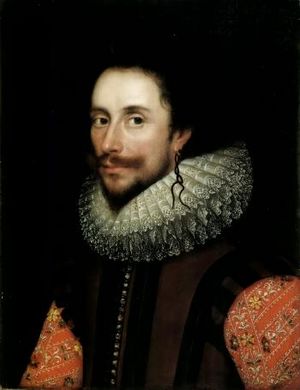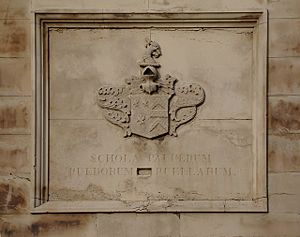Francis Nethersole facts for kids
Sir Francis Nethersole (born 1587, died 1659) was an important English figure. He worked as a diplomat, which means he represented his country in other nations. He was also a secretary to Princess Elizabeth Stuart, who became the Queen of Bohemia. Later, he was elected as a Member of Parliament, helping to make laws. During the English Civil War, he wrote many pamphlets, which were like political essays, sharing his ideas.
Contents
Early Life and Education
Francis Nethersole was born in 1587. He was the second son of John Nethersole from Kent, England.
He earned a scholarship to Trinity College, Cambridge, a famous university. After getting his Master of Arts degree in 1610, he became a popular teacher. In 1611, he was chosen as the university's public orator. This meant he was the official speaker for important events.
Working as a Diplomat
In 1619, Francis Nethersole left his jobs at Cambridge University. He became a secretary to James Hay, who was a viscount (a type of noble). Hay was going to visit the Elector Palatine, a German prince, to help him make peace with his neighbors.
Nethersole was a strong Protestant. He became a big supporter of the Elector and his wife, Princess Elizabeth Stuart. She was the daughter of King James I of England.
When he returned to England, Nethersole was knighted in 1619. This meant he was given the title "Sir." At the same time, he became England's agent to the Protestant Union. This was a group of Protestant states in Germany. He also became the secretary to the Electress Palatine, Princess Elizabeth.
Nethersole went to Prague in 1620. This was after Elizabeth's husband became the King of Bohemia. Nethersole became like England's minister (a top diplomat) at their court.
He sent many detailed reports back to the English government. At first, he thought the Elector would win his battles. But by August 1620, he wrote to King James I that the Elector's situation was hopeless.
In 1621, the Elector sent Nethersole to England to ask for help. They needed help to defend their home, the Palatinate. He returned with bad news: England would not send help.
In 1622, Nethersole came back to England. He was told by George Villiers, the Duke of Buckingham, that England would soon join the Thirty Years' War to help the Elector.
Even though he kept his job as agent to the Electress, Nethersole stayed in England from 1623. He hoped to influence the English government more easily from there. For the next twelve years, he wrote many letters to the Electress.
In 1623, he also went to Spain during talks about a possible marriage between Prince Charles (who would become King Charles I) and a Spanish princess. Nethersole's message was about this marriage and an invitation for the Duke of Buckingham to be a godfather to Elizabeth's son.
In English Politics
Nethersole also spent time on English politics. In 1624, he was elected as a Member of Parliament (MP) for Corfe Castle. He was re-elected for the same area in 1625 and 1628.
In Parliament, Nethersole spoke against the king's power to imprison people without giving a reason.
In 1633, Nethersole tried to raise money for the Electress. He wanted to collect voluntary donations to help her recover the Palatinate. He even got two London merchants to offer a lot of money.
However, his plan became public before it was officially approved. King Charles I was convinced that Nethersole had misled him. The king first put Nethersole under house arrest. Then, he made him apologize and stopped the fundraising plan.
Time in Prison
In December 1633, Nethersole received an urgent letter from the Electress's secretary. She desperately needed help from England. Nethersole sent part of this letter to the king's secretary. He added his own message, suggesting that if no help was sent, the Electress's son might blame his family for his downfall.
King Charles was offended by this suggestion. He ordered Nethersole to be sent to the Tower of London.
Nethersole was released in April 1634. But the king made the Electress promise that she would never hire Nethersole again. This ended his public career.
Writing During the Civil War
After this, Nethersole mainly lived at Polesworth in Warwickshire. He lived on property his wife had inherited. He wrote to Secretary Francis Windebank in 1636, saying he was still loyal to the king.
Nethersole's religious beliefs were very Protestant. Later in his life, he leaned towards Presbyterianism. He helped a minister named Bell get a job in Polesworth. Richard Baxter, a famous writer, said that Bell's loyalty and learning were clear because he was Sir Francis's pastor.
When his father died, Nethersole inherited Nethersole House. Even though he supported the king, he did not fight in the Civil War. However, in 1648, he tried to find a peaceful solution to the war. He wrote several pamphlets (short political writings) to share his ideas.
- On August 15, 1648, he wrote to the leaders of London, asking important questions about the war.
- On August 17, 1648, he published a plan for a fair and lasting peace. He suggested how the king, Parliament, the city, and the army could agree.
- He wrote about the need for a general pardon and forgetting past wrongs on October 30, 1648.
- He also wrote about religious problems on November 3, 1648, and parables (stories with a moral) about the times on November 13, 1648.
On January 11, 1649, Nethersole openly criticized John Goodwin. Goodwin had defended the army's decision to put the king on trial. Nethersole signed his name to this pamphlet and admitted he wrote the earlier ones too.
Later Life and Legacy
Francis Nethersole married Lucy Goodere in February 1620. She was the daughter of Sir Henry Goodere from Warwickshire. Lucy Nethersole died in 1652 at age 58 and was buried in Polesworth Church.
In 1653, after a long legal process, Nethersole settled his estates. Around the same time, he built and funded a free school in Polesworth, as his wife had wished. He also provided money for the local church.
Sir Francis Nethersole passed away in Polesworth in August 1659. A stone was placed in the church in 1859 to remember him.
Francis and Lucy Nethersole did not have any children. However, the Nethersole family line continues today through relatives like Desmond Nethersole-Thompson (1908–1989), who was a distant nephew of Francis.



